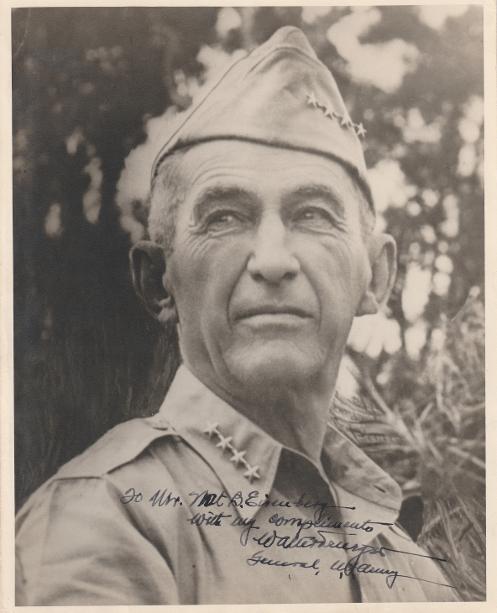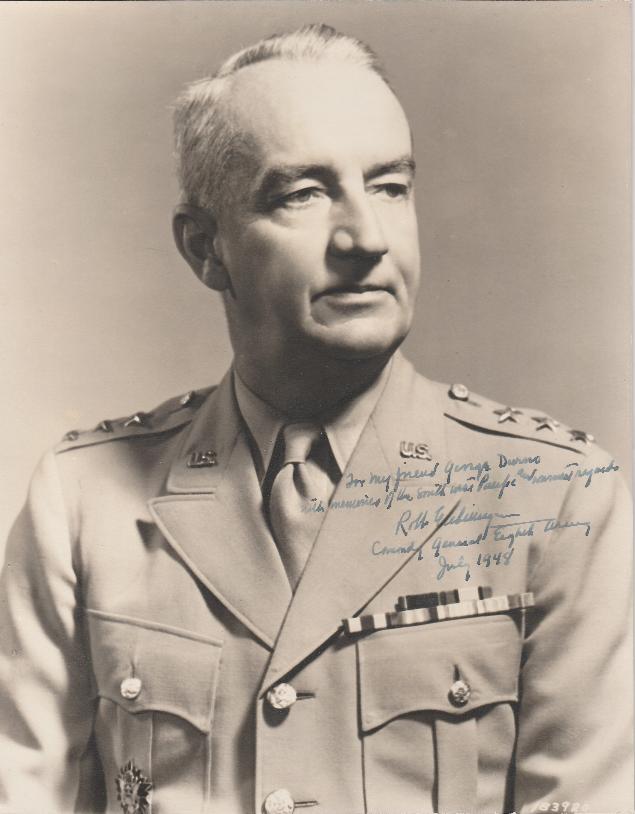MacArthur's WWII South-WestPacific Area Commanders

General Walter Krueger
Born January 26, 1881 at Flatlow, West Prussia (now Zlotow, Poland), he came to the United States with his family at the age of eight.
In 1898 he enlisted for volunteer service in the Spanish-American War, and in 1899, having served in Cuba, he enlisted as a Private in the Regular Army. While serving in the Philippines with the Infantry, he was advanced to the rank of Sergeant and in 1901 was commissioned Second Lieutenant, 30th Infantry.
He returned to the U.S. in 1903, graduated from the Infantry-Cavalry School, Fort Leavenworth, Kansas, in 1906 and from the General Staff College there in 1907. After a second tour in the Philippines, he was assigned to various routine duties. In 1916, he took part in the Mexican Punitive Expedition under General John J. Pershing. He went to France in February 1918 and served as Assistant Chief of Staff of the 26th Division, later with the 84th Division and as Assistant Chief of Staff with the Tank Corps, and then as Assistant Chief of Staff of VI and IV Corps in occupation duty following World War I, advancing to the rank of temporary Colonel.
After periods at the Infantry School, Fort Benning, Georgia, and in command of the 55th Infantry at Camp Funston, Kansas, he attended the Army War College, graduating in 1921 and remaining for a year as an instructor. In 1922-25, he was in the War Plans Division of the General Staff. He graduated from the Naval War College in 1926 and from 1928 to 1932 taught there.
He commanded the 6th Infantry at Jefferson Barracks, Missouri, for two years and then returned to the War Plans Division, becoming Chief of the Division in May 1936 and receiving promption to temporary Brigadier General in October. In June 1938 he went to Fort George G. Meade, Maryland, as commander of the 16th Infantry Brigade. He was promoted to temporary Major General in February 1939, then commanded the 2nd Division at Fort Sam Houston, Texas, rising in October to the command of VIII Corps.
In May 1941 he was promoted to temporary Lieutenant General in command of the 3rd Army and the Southern Defense Command. A month after the activation of the 6th Army in January 1943, he took command, making his headquarters in Australia. He remained in command of the 6th Army, which included in various combinations at different times I, X, XIV and XXIV Corps, throughout its combat period. The operations of the 6th Army included those on Kiriwina and Woodlark Islands, July 1943; New Britain, December 1943-February 1944; Admiralty Islands, February-May 1944; New Guinea, July-August 1944; Morotai, September-October 1944; Leyte and Mindoro, Philippines, October-December 1944; and Luzon, January-February 1945. In September 1945, the 6th Army took up occupation duty at Honshu, Japan. In January 1946 it was deactivated.
Promoted to temporary General in March 1945, he reverted to Lieutenant general in January 1946, but retired as a full General in July 1946. Not only was he an expert on discipline and training, but was also noted as an historian and scholar of military affairs. He published translations of several classic German tests and in 1953 published "From Down Under To Nippon: The Story of the 6th Army In World War II."

General Robert LawrenceEichelberger
Robert Lawrence Eichelberger was a highly popular commander who led many successful operations in the Pacific Theater of Operations during World War II.
He was the Superintendent of the United States Military Academy at time of the Pearl Harbor attack. He was then appointed Commanding General of the 77th Infantry Division in January 1942, and then commander of the United States First Corps, whose staff he took to General Douglas MacArthur's Southwest Pacific Area command in Australia in August of that year with orders to turn back the Japanese Papuan offensive.
He was the only senior United States land commander in the Pacific able to maintain good relationships with his Australian colleagues, in contrast to MacArthur. In December was sent to Buna front in Papau, New Guinea, to revitalize the stalled offensive, winning the first small but important victory against Japanese ground forces there before he took the First Corps onthrough New Guinea to the Huon peninsula and then to American landings at Hollandia in April 1944. Operating as Operation Reckless Task Force, the First Corps Corps began a lightning campaign from Hollandia which secured a major base site for the support of subsequent Allied operations.
He was then Commander of the newly formed Eighth Army from September 1944, and was responsible for all American forces in Dutch New Guinea, for mounting of operations in the southern Philippines and for the cleaning-up operations on Leyte and later Luzon. After fighting in the Philippines ceased, he and his command supervised the surrender of over 50,000 Japanese troops from northern Luzon alone.
He was aboard the USS Missouri in Tokyo Harbor and attended the Japanese surrender there. After the Japanese surrender, he commanded the first occupation forces in Japan and retired in 1948 as overall commander of Allied ground forces in the Japanese home islands.

General George C. Kenney
He is best known as the commander of the Allied Air Forces in the Southwest Pacific Area (SWPA), a position he held from August 1942 until 1945. Kenney enlisted as a flying cadet in the Aviation Section, U.S. Signal Corps in 1917, and served on the Western Front with the91st Aero Squadron. He was awarded a Silver Star and the Distinguished Service Cross for actions in which he fought off German fighters and shot two down. After hostilities ended he participated in the Occupation of the Rhineland. Returning to the United States, he flew reconnaissance missions along the border between the US and Mexico during the Mexican Revolution. Commissioned into the Regular Army in 1920, he attended the Air Corps Tactical School, and later became an instructor there. He was responsible for the acceptance of Martin NBS-1 bombers built by Curtis, and test flew them. He also developed techniques for mounting .30 caliber machine guns on the wings of an Airco DH.4 aircraft. In early 1940, Kenney became Assistant Military Attaché for Air in France. As a result of his observations of German and Allied air operations during the early stages of World War II, he recommended significant changes to Air Corps equipment and tactics. In July 1942, he assumed command of the Allied Air Forces and Fifth Air Force in General Douglas MacArthur's Southwest Pacific Area. Under Kenney's command, the Allied Air Forces developed innovative command structures, weapons, and tactics that reflected Kenney's orientation towards attack aviation. The new weapons and tactics won perhaps his greatest victory, the Battle of the Bismarck Sea, in March 1943. In June 1944 he was appointed commander of the Far East Air Forces (FEAF), which came to include the Fifth, Thirteenth, and Seventh Air Forces. In April 1946, Kenney became the first commander of the newly formed Strategic Air Command (SAC), but his performance in the role was criticized, and he was shifted to become commander of the Air University, a position he held from October 1948 until his retirement from the Air Force in September 1951.